
Salyan

Sherpa style
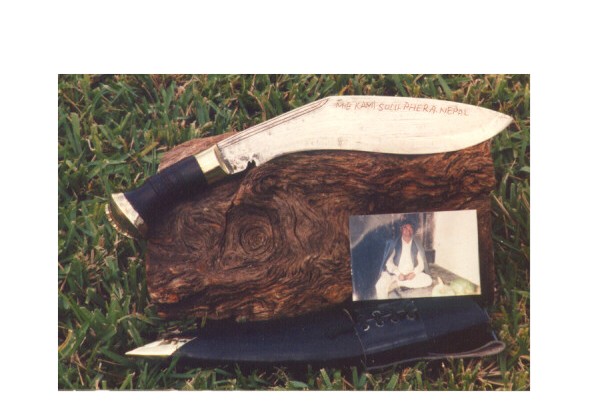
The khukuri made by the kami who made the khukuri the farmer
used to kill the bear is called a "Sherpa style" khukuri -- blade looks
similar to the Salyan style but has a solid brass pommel and very heavy.
BM
sirupati

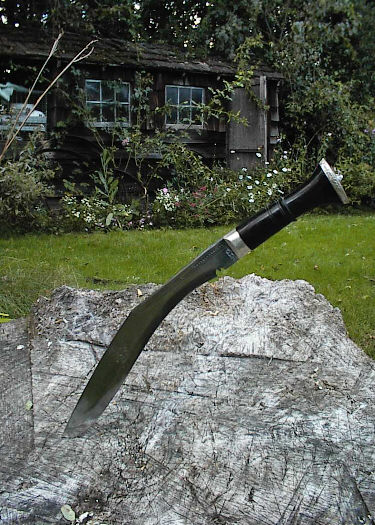
The Sirupati, traditional khukuri of the Rai and Limbu people of Eastern Nepal, is quick and agile which makes it a favorite of martial artists. Excellently balanced. Light but still strong enough to do a heavy day's work. "Sirupati" means leaf point.
The term "Sirupati" is often used to describe any long, slender khukuri. The term may be used in opposition to "Bhojpuri," which is used to describe a thicker style.
20" Sirupati Review by Will
Kwan
12"
and 15" Sirupati Review by Cliff Stamp and more
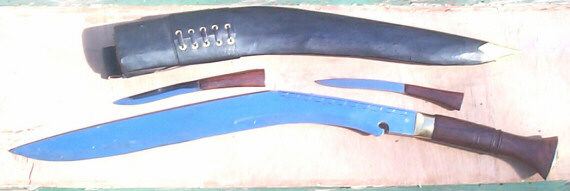
Here is a 30 inch Sirupati. As you can see it is a pretty attractive khukuri and here are the specs.
length -- 30 + a fraction
Width -- 2 inches
Thickness -- almost 5/8
Weight -- 4. 75 pounds about
Karda and chakma are about 8.5 inches, the karda being a using knife
in itself. Two knives for the price of one.
This khukuri is meant for heavy use. Advisor on this particular model was old master Kami, Krishna, who opted for the unusual cho as his mark on the manufacture of the blade. Krishna felt this khukuri might be subjected to very heavy use so advised Kumar to put in the thickness and weight. "Thick blades don't bend or break, thin ones do."
Sisneyri
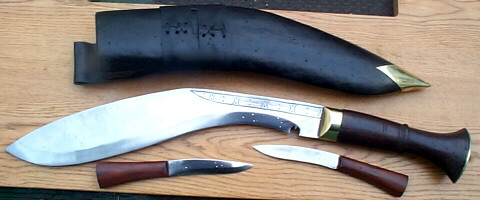

Here's a new one they made at BirGorkha. I don't know which kami made it but whoever it was did a very decent job. They call this khukuri a Sisneyri, named after a village where this style is made.
Overall length is 22 inches, 2.5 inches, wide, 1/2 inch thick, weight about 2.75 pounds. Karda and chakma are 7+ inches.
Of special interest to me was the inlay. Not standard at all -- copper and brass every other notch. This is the first I have seen like this out of maybe 10,000 khukuris and it looks very nice, indeed.
Forgive the raindrops! BM 1/2000
Sossun Patta
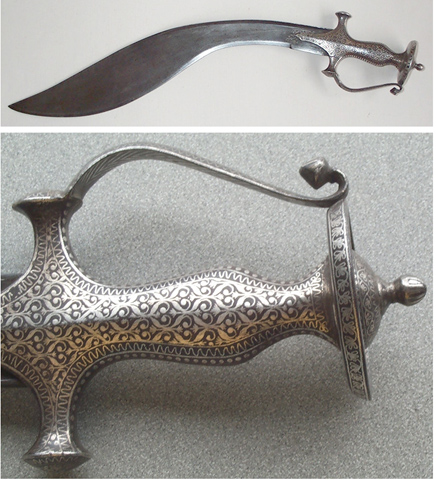
Here's an example of a nice Indian sossun pata in its dagger form. You
can call it a cousin or a great grandpa of the khukuri. Probably from around
mid 19th century. JP 7/01
Tin Chirra
"Tin Chirra" means three groove in Nepali. It is not a triple spine but a double one. Imagine an Ang Khola with another curved spine running just below the first one an inch or so below and you've got it. It is a bit heavier and beefier than the Ang Khola is you can imagine that. It looks just like an Ang Khola with an additional spine below the regular one. BM 11/98

Artwork courtesy of Lee Jones
In the photograph above the green, red and gray areas are depressed. the ridges are yellow. HW
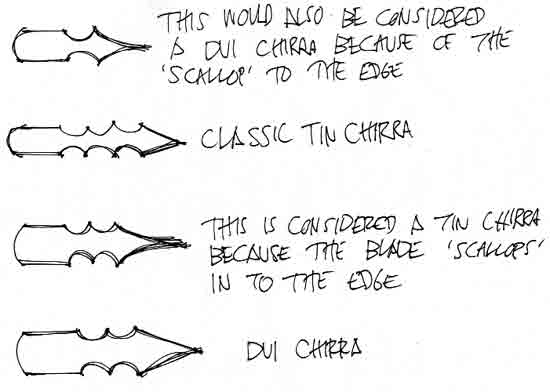

This is a classic tin chirra blade.
Udhaipur (HI Gelbu Special)

This is a pretty old design and it is popular around the village of
Udhaipur and, in fact, is sometimes called an Udhaipur khukuri, or a "full
Ang Khola." An Ang Khola has a smaller fuller near the top of the blade.
If a full fuller extends the full length of blade some kamis will then
call the blade form a full Ang Khola. I do not think this is a proper
name for the khukuri but this is what some call it. This design is
a good one -- easy to use, easy to control, not a log splitter like the
Ang Kholas but strong enough to do decent work and it makes a very effective
weapon. Kami Sherpa
The village Udhaipur pictured above is 16” long and 14 oz. The blade is about 5/16 thick at back and about 1.5 wide. Kami Sherpa says the blade is " very nicely hardened." Surprisingly, the chop still “feels right” with this size blade, and I don't doubt that it could sever a limb. It can be thrust hard into a log with either a forward or reverse grip. The curve of the blade ensures that the force the hand exerts on the knife is not parallel with the handle as it is on a straight bladed knife. This helps to reduce the tendency of the hand to slip forward on a stab. It is light and nimble. There is a deep, forged fuller that extends the length of the blade. (Not just on the forward section like the AK.) This makes the blade even lighter than its size would indicate. The fuller does not show in the photograph. It is light as a feather, but tough enough to split wood. It will chop, albeit not as well as the AK, and the spine is strong enough to be pounded through wood when splitting. I think this is a gentleman's knife, a traveling knife. This knife is light enough to be useful cutting blackberry vines, or other trail type duties. Howard Wallace
Village Udhaipur review by Howard Wallace
The pictured village knife was used as a prototype for a HI production model, the "Gelbu Special."

While the village Udhaipur has a light blade, the Gelbu Special has
a considerably heavier blade. It is more than 7/16 inch thick at
the back of the blade but narrows to about 1/4 inch or perhaps a bit less
at the center of the fuller. The pictured Gelbu Special is
about 19 inches long and weighs 1.5 lbs.
WWII
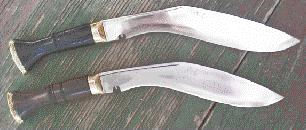
The workhorse of the Gurkas during WWII, this model saw service in both
Europe and Pacific theaters. This is probably the best combination of weapon
and tool that can be had. This khukuri is the favorite of many Bando practitioners.
Will
Kwan's review of the 15" AK and the WWII
On Low Quality Indian Import Khukuris
India is a very poor country with a great many people. They do what they must to survive. I think that most of the khukuris that are made for export are made at Dehre Dun. They have hundreds of men pounding steel all day as fast as they can. They are not aiming for quality but for maximum production. The last I checked you could buy a khukuri at the factory for 3 USD -- it may be a little more today. When I upgrade my scabbards I will be paying 3 USD for the leather on the scabbard alone. This will give you some idea as to the difference. But amazingly sometimes you can find one of these Indian khukuris that is pretty good and there are village kamis in India that make excellent khukuris.
Just a couple of days back I received a catalog from some company offering a "genuine Gurka khukuri" for $11.95! It was made in India and the ad said this is what the Gorkhalis carried. I laughed.
Pala (Kami Sherpa)
I've seen quite a few khukuris used by the Gorkhas, and even the
beat-up ones which were used to clear fields, chop wood, hammer posts,
kitchen-use, etc. were all solid pieces, even if they might be rough n'
ugly lookin' as compared to the service khukuris carried in parades and
inspections. These rough n' ready "general-use" khukuris were either older
"retired" service khukuris, or something they brought back from their villages
(a villager khukuri), or something that the regimental kami made for such
purposes.
That's why when I first moved to the US, I was taken aback to find
these ugly and weird khukuris being sold as genuine official-issue Indian
Army Regimental kukris. Yes, I have seen such khukuris - being sold to
gullible tourists who don't know any better. Never did I see such "official-issue"
khukuris among the Gorkhas. If a Gorkhali were to be given such a khukuri,
he'd probably toss it aside and say something like "Theek chhai-na" or
"Ramro chhai-na" (Not correct/Not good).
- Sonam
Yesterday my wife Janet and I went on a blackberry picking expedition. The quarry was the fruit of Rubus discolor, the Himalayan Blackberry. This is an invasive, non-native species of European origin, that grows extremely well here in the Pacific Northwest. On such expeditions a knife usually accompanies us, to cut canes blocking access to the fruit, to clear paths, and to release ourselves when entangled in the thorny canes. Cutting the canes can be a challenge, as they are quite flexible, and the older growth can be fibrous and woody. In the past I have used knives such as a Randall #1, a Blackjack Trailguide, and a large old carbon-steel butcher knife, each honed to razor sharpness.
This year I tried out the light Udhaipur khukuri.
Prior to taking it out I touched up the edge to shaving sharpness on some crock sticks. I found that with the addition of a wrist snap, I could get the blade moving at high speed. This is ideal for cutting a tough cane that can, if given a chance, bend and flex with the force of the attempted cut. The Udhaipur easily handled the thickest (approximately 1.25") and woodiest of the canes I tried it on. Using the Udhaipur was not fatiguing, due to its light weight. The crook in the blade tends to pull a flexible cane into the knife, so the cut can be completed. With a straight knife the cane will sometimes slide off the knife prior to the completion of the cut. The bent blade was also helpful when gently bending a high fruit laden cane down to our hands.
I was not wearing a belt, so carry was problematic at first. It rode out to the berry patch in our large enamel pot, but once we started picking it found a comfortable home in its sheath, the last few inches stuck in the thigh pocket of my shorts. Again, the light weight made this carry comfortable and secure, whereas it would not have been for a heavier blade.
Using the Udhaipur was a lot of fun. I even took some time off from berry picking to open up a trail to the river that was becoming choked with blackberry vines.
We have several gallons of blackberries now, so I won't be back to the patch anytime soon, but I think the Udhaipur will have another chance to accompany me berry picking next year.
My Shop 2, 20” Sirupati has been used on and off for the last three
weeks. It is the last of the Sirupati with
the suspect tang. It weights 909 g (2 lb.) and has a total overall
length of 21”. The blade is 0.4” thick at its
thickest point. The blade spine to edge distance is much smaller than
an Ang Khola or WWII model. This
gives the Sirupati and eel like appearance. The Sirupati’s forward
angle and belly are not as great as the
WWII or Ang Khola’s. The Sword of Shiva is decorated with nice brace
inlaying. The Chakma and
Karda are about 6” overall. The smaller knife was actually beveled
and sharpened.
The Sirupati is neutrally balanced. It feels more like a 15” Ang Khola
(635 g) and much lighter than an 18”
Ang Khola (967 g). The Sirupati is easily stopped even when swing against
no resistance.
First the tang was tested. The flats of the blade was struck against
heavy wood working tables and then
against a large tree. There is a lot more vibration than regular chopping.
The tang did not break and even
the horn handle was undamaged (no hairline cracks).
The blade was chopping sharp out of the box. I sharpened it by free
hand with the course Lansky stone,
followed by the Spyderco course stone. It would easily remove hair
off my arms in after about 20 minutes
work.
On the first trip out the Sirupati was used to chop up fallen trees
and branches, about 5-6” in diameter.
The Sirupati chopped through these with no trouble. Penetration is
not as good as the WWII or Ang
Khola of similar weight. This is due to the more neutral weight distribution
and less belly on the Sirupati. To
test the tang some more I chopped the knife into the fork of a small
tree. The diameter of the tree is about
4”. The fork caught the blade about 4” from the tip. I pushed on the
handle with my full weight. The tree
flexed but the Sirupati blade did not appear to even deflect. I applied
more pressure by digging my feet in
and was able to twist part of the tree off. Next I chopped closer to
the ground on some particularly dirty
branches (7”-8”). I stopped after seeing sparks fly off the blade.
It was now too dark to examine the blade
for damage.
No damage was found on the blade when it was examined at home. The
knife would not shave hair. There
is a slight burr running along the right side of the edge. This seems
normal for me since I am right handed.
The chakma was used to steel the edge. The Sirupati would shave after
steeling. I finished off my lightly
running the Spyderco white ceramic stones over the blades. I found
two very small nicks about 0.01” in
diameter after the Spyderco stones were used. This is probably from
chopping what ever caused the
sparks. The only damage I could find was that the butt cap was a bit
crooked. I straighten it up but did not
bother to apply epoxy as it was still quite tight.
The Sirupati excelled at trail clearing. I have a 300 m trail which
needs to be routinely cleared so that the
4x4 does not get too scratched up. Mainly, dead branches on Spruce
and Pine trees must be chopped
down. The branches have a maximum diameter of 3” and are typically
well dried. The Sirupati could
cleave through or snap off the branches with one swing. After, the
branch was downed the knife could
easily be brought to a stop. As Cliff points out for this type of work
energy is wasted in stopping the blade.
The extra reach was valuable to keep me further away from the branches
thus preventing me from
scratching my hand up as well.
In summary I liked my muscular Sirupati and I must thank Bill for selecting
the heavier one for me. The
edge is easily maintained and seems quite durable. The handle is quite
tough. The neutral weight balance
makes it more versatile for task where heavy chopping is not required.
If required the Sirupati can do
heavy chopping.
Well, so far my tests with the Khukuri from HI are very impressive as
weapons. The three sizes 15", 20" and the 25" Sirupatis were tested as
weapons and not on normal wilderness chores. I wanted to find out if these
Sirupati style Khukuris would perform like the other blades I use (Moro
Kris/Sundang, Moro Barong, Kampilan, Celtic style sword, and Japanese Katanas
and wakizashi). I tested the Khukuris on tatami rolls with a dried bamboo
core. The rolls measured about 4.5" to 5" in diameter, and the bamboo core
was about 1" to 1.5" in diameter. The rolls were soaked for three days,
and the dried core (dried yellow bamboo, not green bamboo) was inserted
prior to testing.
I set up my target stand which is set up similar to the Blair Witch
Project symbol. The arms, legs, head and body are all made of tatami rolls.
Making the bamboo frames ahead of time helped in the assembly of my test
targets. I had two targets for each Khukuri. The first target I stood there
and performed various cuts to each part of the target. The second target
was reserved for a charging attack on each part of the target. The first
Khukuri in my test was the 15" Sirupati. This little Khukuri was very impressive
for its size. The 15" performed like a large sharp knife, similar in performance
to my old Blackjack Mamba. The cuts were very deep, and even though it
didn't severe the parts completely off, it would do tremendous damage if
it was a real person. While charging at the target, the cuts were very
deep, and came very easy. The 15" handles alot faster, than the Mamba,
and CS Trailmaster, but cuts just a little bit deeper per attack. Next,
the 20" Sirupati. This puppy acted like a long sword in cutting, but not
in reach. The 20" easily cut through any portion on my tatami man.
This Sirupati was very fast for it size. My Wakizashi performs well, but
the 20" has an edge in cutting thick targets because of the p.o.b. being
farther from the handle. My Wak is more neutral in feel, compared to the
20" Sirupati. While charging at my tatami man, this target didn't have
any chance. The limbs, head ,and torso were severed in half! Definitely
a nice large knife/short sword to have if you needed a blade to somewhat
conceal, but still have the cutting power of a larger sword. The last is
the 25" Sirupati. This Khukuri is meant for someone with armor! The 25"
is not as agile as the 15" or 20", but it does have a purpose. The 25"
cuts like a dream, but if you want multiple fast strikes, you should pick
another type of Khukuri. Maybe a 30" Kumar Kobra. This 25" Sirupati would
be a good pack Khukuri/sword. The charging attacks I did with this one
really surprised me. I hardly noticed any resistance in the actual cut.
The weight of blade made sure, that I had enough momentum for the cut.
One thing I noticed about my little testing, is that these Khukuris
are real weapons. The Sirupati style passed with honors. I would like to
test various model out in the future. I know some styles are used for normal
chores, that's fine, but in a pinch the could save your life. One last
note, all the Sirupatis did not receive any damage to the edge at all.
I did sharpen them a little bit prior to use, and the edges held.. . The
curved blades do cut better (Katana, Kris/Sundang, and the Khukuri) than
the straight blade styles (Kampilan, you need to use the draw cut technique
with this blade).
Copyright (c) 1999-2001 by Howard Wallace, all rights
reserved.
This FAQ may not be included in commercial collections
or compilations, or distributed for financial gain, without express written
permission from the author. This FAQ may be printed and distributed
for personal non-commercial, non-profit usage, or as class material, as
long as there is no charge, except to cover materials, and as long as this
copyright notice is included.